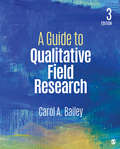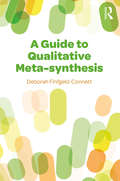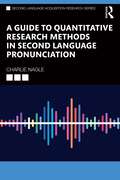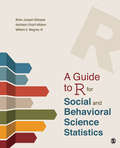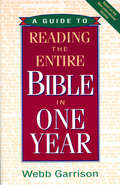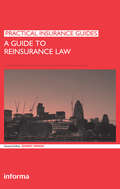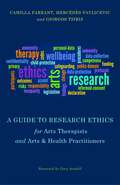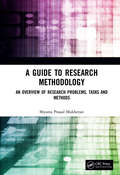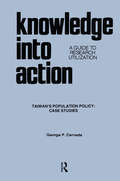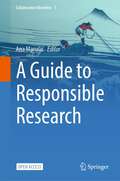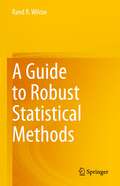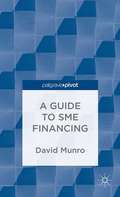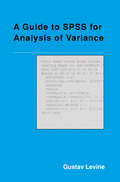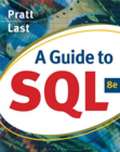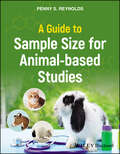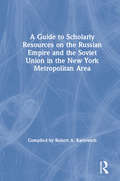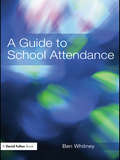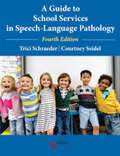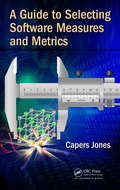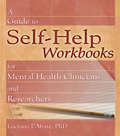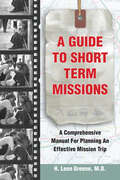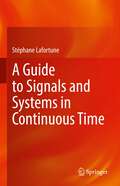- Table View
- List View
A Guide to Qualitative Field Research
by Carol R. BaileyA Guide to Qualitative Field Research provides readers with clear, practical, and specific instructions for conducting qualitative research in the field. In the expanded Third Edition, Carol A. Bailey gives increased attention to the early and last stages of field research, often the most difficult: selecting a topic, deciding upon the purpose of your research, and writing the final paper, all in her signature reader-friendly writing style. This edition features research examples from graduate and undergraduate students to make examples meaningful to fellow students; a new "Putting It All Together" feature, with examples of how different parts of the research process interact; and more emphasis on the "nuts and bolts" of research, such as what to include in an informed consent form, a proposal, and the final paper.
A Guide to Qualitative Field Research
by Carol R. BaileyA Guide to Qualitative Field Research provides readers with clear, practical, and specific instructions for conducting qualitative research in the field. In the expanded Third Edition, Carol A. Bailey gives increased attention to the early and last stages of field research, often the most difficult: selecting a topic, deciding upon the purpose of your research, and writing the final paper, all in her signature reader-friendly writing style. This edition features research examples from graduate and undergraduate students to make examples meaningful to fellow students; a new "Putting It All Together" feature, with examples of how different parts of the research process interact; and more emphasis on the "nuts and bolts" of research, such as what to include in an informed consent form, a proposal, and the final paper.
A Guide to Qualitative Meta-synthesis
by Deborah Finfgeld-ConnettA Guide to Qualitative Meta-synthesis provides accessible guidelines for conducting all phases of theory-generating meta-synthesis research, including data collection, analysis, and theory generation. It is a research methodology that is designed to generate evidence-based theory by extracting, analyzing, and synthesizing qualitative findings from across published investigations. These theories provide scaffolding that can be used by health-care providers and other professionals to make context-based decisions and implement situation-specific actions. Theory-generating meta-synthesis methods stem from the qualitative research paradigm, especially grounded theory. Systematic and rigorous methods are used to identify topically related research reports that provide qualitative findings for analysis. The subsequent analysis of the data goes beyond merely reorganizing and recategorizing research findings. Newly synthesized concepts are developed, and the dynamic relationships among them are fully articulated. The validity of the resultant theory is ensured based on theoretical, methodological, and researcher triangulation; unbiased data collection and sampling strategies; inductive-deductive data analysis and synthesis strategies; and continuous reflexivity. Meta-synthesis-generated theories are highly important in environments where the use of normalized algorithms, guidelines, and protocols are on the rise. The types of theories discussed in this book will help service providers customize standardized tools so that the most effective evidence-based, yet individualized, interventions can be implemented.
A Guide to Quantitative Research Methods in Second Language Pronunciation (ISSN)
by Charlie NagleThis book offers a comprehensive resource on the state-of-the-art in L2 pronunciation, surveying the most up-to-date theoretical and methodological developments to highlight the multidimensional nature of pronunciation scholarship and directions for future research. The volume examines both speech perception and production, including the perception-production link. The book explores production from a range of perspectives, including acoustic analysis of specific features and listener-based ratings of global dimensions of pronunciation. Each chapter spotlights a different dimension of pronunciation through a consistent structure, including a summary of the latest research, a critical appraisal of methods, and an overview of data analysis procedures with recommendations for practical implementation. The innovative interconnected structure allows readers to build on their knowledge with each successive chapter while also allowing the flexibility to use chapters as standalone units depending on individual interests. A concluding chapter outlines a research agenda for future scholarship, spotlighting the methods and approaches that are most likely to advance the field. This book is an invaluable resource for graduate students and researchers, at all stages of their careers, looking to expand their knowledge base in SLA and L2 pronunciation and related fields such as phonetics and phonology.
A Guide to R for Social and Behavioral Science Statistics
by Brian Joseph Gillespie Dr. William E. Wagner Kathleen Charli HibbertA Guide to R for Social and Behavioral Science Statistics is a short, accessible book for learning R, geared toward social and behavioral science students. Instructors Brian Gillespie, Kathleen Hibbert, and William E. Wagner, III, have combined a review of introductory statistics with an introduction to R to teach readers two of the most valuable skills for research and in the workplace. Designed for readers with no knowledge of statistics or R, A Guide to R for Social and Behavioral Science Statistics follows the most common progression of statistics, starting with basic descriptive statistics, and continuing up through inferential statistics and regression. This text provides step-by-step instructions for working with R, starting with downloading and installing R and RStudio®, featuring code and output so readers can follow along with each step. Readers can apply their knowledge with examples and exercises featuring data from the General Social Survey in each chapter. Tips on R show users how to avoid common pitfalls in R and most efficiently use the RStudio interface. With frequent reminders of statistical concepts to accompany instructions and tips in R, this text helps readers master R for statistics in the social and behavioral sciences.
A Guide to R for Social and Behavioral Science Statistics
by Brian Joseph Gillespie Dr. William E. Wagner Kathleen Charli HibbertA Guide to R for Social and Behavioral Science Statistics is a short, accessible book for learning R, geared toward social and behavioral science students. Instructors Brian Gillespie, Kathleen Hibbert, and William E. Wagner, III, have combined a review of introductory statistics with an introduction to R to teach readers two of the most valuable skills for research and in the workplace. Designed for readers with no knowledge of statistics or R, A Guide to R for Social and Behavioral Science Statistics follows the most common progression of statistics, starting with basic descriptive statistics, and continuing up through inferential statistics and regression. This text provides step-by-step instructions for working with R, starting with downloading and installing R and RStudio®, featuring code and output so readers can follow along with each step. Readers can apply their knowledge with examples and exercises featuring data from the General Social Survey in each chapter. Tips on R show users how to avoid common pitfalls in R and most efficiently use the RStudio interface. With frequent reminders of statistical concepts to accompany instructions and tips in R, this text helps readers master R for statistics in the social and behavioral sciences.
A Guide to Reading and Writing Japanese
by Janet Ikeda Kenneth Henshall Christopher Seeley Henk De GrootThis is an essential study tool for students seeking to learn Japanese and dramatically improve their kanji and kana. Students have been reading and writing Japanese for centuries, and they build their knowledge most successfully when they rely on a trusted resource. Today's most trusted-and readily available-resource is A Guide to Reading and Writing Japanese. This classic, best-selling learning and reference work, trusted by beginning and intermediate students learning Japanese since 1959, is now being offered as a fourth edition and is thoroughly revised and up-to-date. Having a knowledge of the full set of General Use characters, which this guide includes, will allow reading of any Japanese newspaper with ease and confidence. Key features on this revised edition include: The most recent changes prescribed by the Japanese Ministry of Education. Covers all the 2,136 characters in the 'General Use' / Joyo Kanji set. Detailing coverage of the 1,009 'Essential' Japanese characters arranged by grade for children in the first six years of grade school. The Kanji characters based more on their frequency in everyday language than the complexity of their composition.
A Guide to Reading the Entire Bible in One Year
by Webb GarrisonEven though there is no better way to let God speak to you, reading the entire Bible-all 66 books and 1,186 chapters-can be intimidating. A Guide to Reading the Entire Bible in One Year overcomes this intimidation by providing a clear, easy-to-follow guide that takes you from Genesis, the book of beginnings, to Revelation, the last book of the Bible.As you discover how God worked in the lives of people in the Bible, you will better understand what difference God can make in your own life. "From the first page to the last," says Webb Garrison, "the Bible offers the incredible story of God's great acts designed to enable folks like us to burst the shackles of humanity."
A Guide to Reinsurance Law (Practical Insurance Guides)
by Robert MerkinThis practical guide offers a useful introduction to reinsurance, taking you step by step through the associated issues you really need to know about. An introduction is provided, setting the scene for further chapters on key topics such as the formation of agreements, terms, rights and obligations. The book covers the following areas: Nature of Reinsurance, Formation of Reinsurance, Agreements, Utmost Good Faith, Terms of Reinsurance Agreements, Rights and Obligations of the Parties, Follow the Settlements and Follow the Fortunes, Claims, Intermediaries, Jurisdiction and Applicable Law, Arbitration.
A Guide to Research Ethics for Arts Therapists and Arts & Health Practitioners
by Gary Ansdell Mercedes Pavlicevic Camilla Farrant Giorgos TsirisThis practical guide aims to inspire ethically-aware practitioners to become ethically-aware researchers, evaluators and participants. Conducting a research project, whatever the setting, requires not only knowledge of research methods but also an in-depth understanding of research ethics. Embedded in 'real life' experiences of research ethics applications, this guide navigates the reader through research ethics procedures, drawing from legislation and a range of research ethics committee regulations. Although the emphasis is on research, ethical considerations presented in this guide are equally relevant and applicable to other types of enquiry, including monitoring and evaluation projects. Whether leading a research project, being part of a research team or taking part as a research participant, this book is essential reading for all arts & health practitioners and arts therapists.
A Guide to Research Methodology: An Overview of Research Problems, Tasks and Methods
by Shyama Prasad MukherjeeResearch Methodology is meant to provide a broad guideline to facilitate and steer the whole of a research activity in any discipline. With the ambit and amount of research increasing by the day, the need for Research Methodology is being widely appreciated. Against this backdrop, we notice the dearth of well-written books on the subject. A Guide to Research Methodology attempts a balance between the generic approach to research in any domain and the wide array of research methods which are to be used in carrying out different tasks in any research. Discussions on these research methods appropriate in various disciplines have focused on the research tasks, keeping in mind the fact that a single such task like a comparison among alternatives may involve several methods from seemingly distinct areas. Unique features of this volume, as will be evident to a discerning reader, include: A detailed discussion on problem areas for research in several domains An illustrative and ampliated list of research problems drawn from different disciplines which can be pursued by interested research workers A comprehensive delineation of Research Design supported by illustrations An elaborate engagement with models with a note on model uncertainty Focus on recent and emerging models, methods and techniques A novel treatment of data analysis where the nature of data and the objective(s) of analysis justify drawing upon a variety of techniques for analysis This book will serve the purpose of a pre-PhD or a Master-level course-work for students of any discipline with a basic knowledge of quantitative analysis. In fact, anyone aspiring to take up meaningful research work will find the content useful and interesting.
A Guide to Research Utilization: A Guide to Research Utilization
by George Peter CernadaAims to describe why and how applied research carried out in a national public health program sometimes influenced program action in the field - and sometimes did not. This title presents and analyses a number of modified case studies to draw some practical lessons and to provide a theoretical basis for future program action.
A Guide to Responsible Research (Collaborative Bioethics #1)
by Ana MarušićThis Open Access book is a guide to good, responsible research at each step of the process of research discovery, so that a researcher at the beginning of a scientific career has a clear pathway to doing good research and producing reliable results.The textbook will give context to the practices described in the European Code of Conduct for Research Integrity, guided by the fundamental principles or research integrity – reliability, honesty, respect, and accountability. Although we base the book on the European Code, the principles are the same in the global research community, such as those outlined in Fostering Integrity in Research from the US National Academies; Engineering and Medicine. The chapters in the book follow good research practices, give practical advice and address basic principles. In this way, the book is applicable to different research fields. It directs readers to various sources for further and updated information, particularly drawing from the resources available at The Embassy of Good Science, the European platform for research integrity and ethics.
A Guide to Robust Statistical Methods
by Rand R. WilcoxRobust statistical methods are now being used in a wide range of disciplines. The appeal of these methods is that they are designed to perform about as well as classic techniques when standard assumptions are true—but they continue to perform well in situations where classic methods perform poorly. This book provides a relatively non-technical guide to modern methods. The focus is on applying modern methods using R, understanding when and why classic methods can be unsatisfactory, and fostering a conceptual understanding of the relative merits of different techniques. A recurring theme is that no single method reveals everything one would like to know about the population under study. An appeal of robust methods is that under general conditions they provide much higher power than conventional techniques. Perhaps more importantly, they help provide a deeper and more nuanced understanding of data. The book is for readers who had at least one semester of statistics, aimed at non-statisticians.
A Guide to SME Financing
by David MunroA Guide to SME Finance is a brief guide to designing and implementing a SME finance program within a commercial bank or other financial institution, such as an NGO.
A Guide to SPSS for Analysis of Variance
by Gustav LevineThis book offers examples of programs designed for analysis of variance and related statistical tests of significance that can be run with SPSS. The reader may copy these programs directly, changing only the names or numbers of levels of factors according to individual needs. Ways of altering command specifications to fit situations with larger numbers of factors are discussed and illustrated, as are ways of combining program statements to request a variety of analyses in the same program. The first two chapters provide an introduction to the use of SPSS, Versions 3 and 4. General rules concerning the use of commands, subcommands, and keywords are discussed, providing a specific introduction to the use of SPSS for analysis of variance. They provide detailed programs for obtaining omnibus F tests in completely randomized designs and for designs that include repeated measures factors. The remaining chapters may be read independently and in any order.
A Guide to SQL (Eighth Edition)
by Mary Z. Last Philip J. PrattA GUIDE TO SQL, 8E, continues to be the essential SQL reference. It builds on the success of previous editions by presenting basic SQL commands in the context of a running case in which a business uses SQL to manage orders, parts, customers, and sales reps. The book covers the fundamentals of SQL programming using straightforward instruction and extensive hands-on exercises. Continuing with its focus on learning the basics regardless of the database environment chosen, this edition features examples from the latest databases: Oracle 11g, Access 2007, and MySQL. The eighth edition expands on the use of running case studies by adding a third running case to the extensive hands-on pedagogy at the end of every chapter.
A Guide to Sample Size for Animal-based Studies
by Penny S. ReynoldsA Guide to Sample Size for Animal-based Studies Understand a foundational area of experimental design with this innovative reference Animal-based research is an essential part of basic and preclinical research, but poses a unique set of experimental design challenges. The most important of these are the 3Rs − Replacement, Reduction and Refinement − the principles comprising the ethical framework for humane animal-based studies. However, many researchers have difficulty navigating the design trade-offs necessary to simultaneously minimize animal use, and produce scientific information that is both rigorous and reliable. A Guide to Sample Size for Animal-based Studies meets this need with a thorough, accessible reference work to the subject. This book provides a straightforward systematic approach to “rightsizing” animal-based experiments, with sample size estimates based on the fundamentals of statistical thinking: structured research questions, variation control and appropriate design of experiments. The result is a much-needed guide to planning animal-based experiments to ensure scientifically valid and reliable results. This book offers: Step-by-step guidance in diverse methods for approximating and refining sample size Detailed treatment of research topics specific to animal-based research, including pilot, feasibility and proof-of-concept studies Sample size approximation methods for different types of data − binary, continuous, ordinal, time to event − and different study types − description, comparison, nested designs, reference interval construction and dose-response studies Numerous worked examples, using real data from published papers, together with SAS and R code A Guide to Sample Size for Animal-based Studies is a must-have reference for preclinical and veterinary researchers, as well as ethical oversight committees and policymakers.
A Guide to Scholarly Resources on the Russian Empire and the Soviet Union in the New York Metropolitan Area
by Robert A. KarlowichIdentifies collections held by public and university libraries, historical societies, and other institutions, as well as private collections, with material relating to any subject and historical period, and to the widest geographical area under imperial or Soviet rule. Includes movements for example
A Guide to School Attendance
by Ben WhitneyImproving school attendance remains a contentious topic and is a high priority for the DCFS, local authorities and schools. Thousands of sessions are missed every day; a waste of money, resources and, most of all, of opportunity. A school’s practice is now subject to scrutiny as never before, with targets and standard procedures required. A Guide to School Attendance provides a detailed practical guide for school leaders and managers, teachers, Education Welfare Officers and other attendance workers in schools and local authorities. New Registration Regulations have been force since September 2006. All state-maintained schools have a legal duty to combat unauthorised absence, to maintain a twice-daily attendance record for every pupil and have attendance policies and procedures ready for OFSTED inspections. These should define everyday practice in all schools but are not always widely known about by those on the front-line. Ben Whitney draws together twenty years of education welfare experience to provide a wealth of ideas to benefit any school. The book provides: summaries of the legal requirements extended case studies Question and Answer sections group work activities model policies and procedures
A Guide to School Services in Speech-Language Pathology
by Trici Schraeder Courtney SeidelA Guide to School Services in Speech-Language Pathology, Fourth Edition serves as a comprehensive textbook for school-based speech-language pathology (SLP) courses and college students who are ready to embark on their student teaching experiences. With its summaries of cutting-edge research, evidence-based clinical approaches, workload solutions, and strategies for professionalism, the book is also a useful resource for practicing, school-based SLPs. The text begins by providing a brief history of school-based SLP services. It highlights the legal mandates set forth in the Individuals with Disabilities Education Improvement Act; provides a review of the No Child Left Behind Act; offers new information about the Every Student Succeeds Act and the Americans with Disabilities Act; and summarizes court cases that have influenced and shaped school services. Then, the text delves into a description of service delivery models; provides valuable information about a workload analysis approach to caseload standards in schools; offers examples of how to write IEPs that reflect workload solutions; shares examples of implementation strategies; and offers concrete, real-life workload success stories. In addition, this text provides practical strategies for using evidence-based practice, proactive behavior management, conflict resolution, professional collaboration, conferencing and counseling skills, cultural competencies, goal writing, informal assessment procedures, and testing accommodations, including methods for conducting assessments for dual language learners. The final chapter provides the evidence base for links between language, literacy, and the achievement of school standards. This chapter is a must-read for every school SLP.
A Guide to Selecting Software Measures and Metrics
by Capers JonesGoing where no book on software measurement and metrics has previously gone, this critique thoroughly examines a number of bad measurement practices, hazardous metrics, and huge gaps and omissions in the software literature that neglect important topics in measurement. The book covers the major gaps and omissions that need to be filled if data about software development is to be useful for comparisons or estimating future projects. Among the more serious gaps are leaks in reporting about software development efforts that, if not corrected, can distort data and make benchmarks almost useless and possibly even harmful. One of the most common leaks is that of unpaid overtime. Software is a very labor-intensive occupation, and many practitioners work very long hours. However, few companies actually record unpaid overtime. This means that software effort is underreported by around 15%, which is too large a value to ignore. Other sources of leaks include the work of part-time specialists who come and go as needed. There are dozens of these specialists, and their combined effort can top 45% of total software effort on large projects. The book helps software project managers and developers uncover errors in measurements so they can develop meaningful benchmarks to estimate software development efforts. It examines variations in a number of areas that include: Programming languages Development methodology Software reuse Functional and nonfunctional requirements Industry type Team size and experience Filled with tables and charts, this book is a starting point for making measurements that reflect current software development practices and realities to arrive at meaningful benchmarks to guide successful software projects.
A Guide to Self-Help Workbooks for Mental Health Clinicians and Researchers
by Luciano L'AbateNever has the need for a compendium of self-help workbooks been so great! From the founder of the world&’s first PhD program in Family Psychology comes an extensive guide to nearly all of the mental health workbooks published through 2002. Placed together in one volume for the first time, A Guide to Self-Help Workbooks for Mental Health Clinicians and Researchers includes reviews and evaluates the complexity of each workbook in regards to its form, content, and usability by the client. From abuse to women&’s issues, this annotated bibliography is alphabetized by author, but can also be researched by subject. While self-help workbooks are currently not as popular or as mainstream as self-help books and video, that could soon change. Self-help workbooks are versatile, cost-effective, and can be mass-produced. The workbook user is active rather than passive, and the mental healthcare worker can analyze a more personal response from the user, whether in the office or via the Internet. A Guide to Self-Help Workbooks for Mental Health Clinicians and Researchers brings these workbooks together into one sourcebook to suit anyone&’s needs. Each self-help workbook is reviewed according to specific criteria: contents structure specificity goal level of abstraction a subjective evaluation usually concludes the review of the workbook A Guide to Self-Help Workbooks for Mental Health Clinicians and Researchers also includes: an in-depth introduction discussing the need for workbooks in mental health practices indices for subject as well as author an address list of the publishing houses for the workbooks annotated in the bibliography an Informed Consent Form to verify compliance with ethical and professional regulations before administering a workbook to a client A Guide to Self-Help Workbooks for Mental Health Clinicians and Researchers offers you a complete resource to self-help workbooks for all mental health subjects. Dr. L&’Abate&’s highly selective review process helps you find exactly what you need. This unique sourcebook is vital for mental health clinicians, counselors, schoolteachers, and college and graduate students.
A Guide to Short-Term Missions: A Comprehensive Manual for Planning an Effective Mission Trip
by H. Leon GreeneThe rewards of a short-term mission trip can be inestimable, but they are not automatically guaranteed. Good planning and thorough research can make the all the difference in having a successful trip. Drawing on his experiences from over thirty short-term missions trips, Dr. Greene gives a detailed look at the challenges and blessings faced by those who are considering such an endeavor. This one-stop guide helps make the most of this opportunity by outlining the steps to take from start to finish.Preparing a testimonyWriting a support letterGetting a passportForming the teamHow to stay healthyEmergency plans and disaster reliefHow and what to prepare forImmunizations neededPacking checklistOther helpful resources
A Guide to Signals and Systems in Continuous Time
by Stéphane LafortuneThis textbook is a concise yet precise supplement to traditional books on Signals and Systems, focusing exclusively on the continuous-time case. Students can use this guide to review material, reinforce their understanding, and see how all the parts connect together in a uniform treatment focused on mathematical clarity. Readers learn the “what”, “why” and “how” about the ubiquitous Fourier and Laplace transforms encountered in the study of linear time-invariant systems in engineering: what are these transforms, why do we need them, and how do we use them? Readers will come away with an understanding of the gradual progression from time-domain analysis to frequency-domain and s-domain techniques for continuous-time linear time-invariant systems. This book reflects the author’s experience in teaching this material for over 25 years in sophomore- and junior-level required engineering courses and is ideal for undergraduate classes in electrical engineering.
